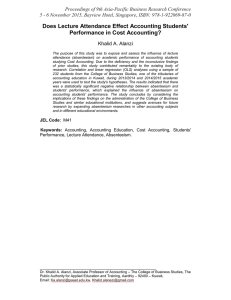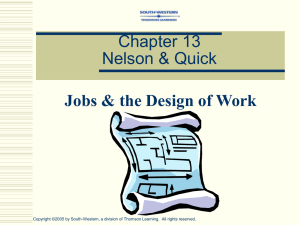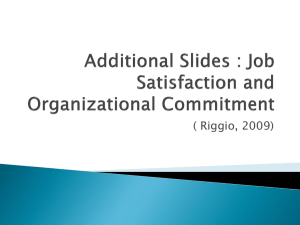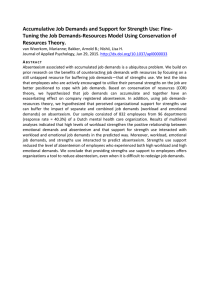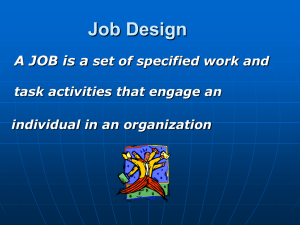A Comparative Study of Job Satisfaction and Absenteeism Group Hawkeye
advertisement
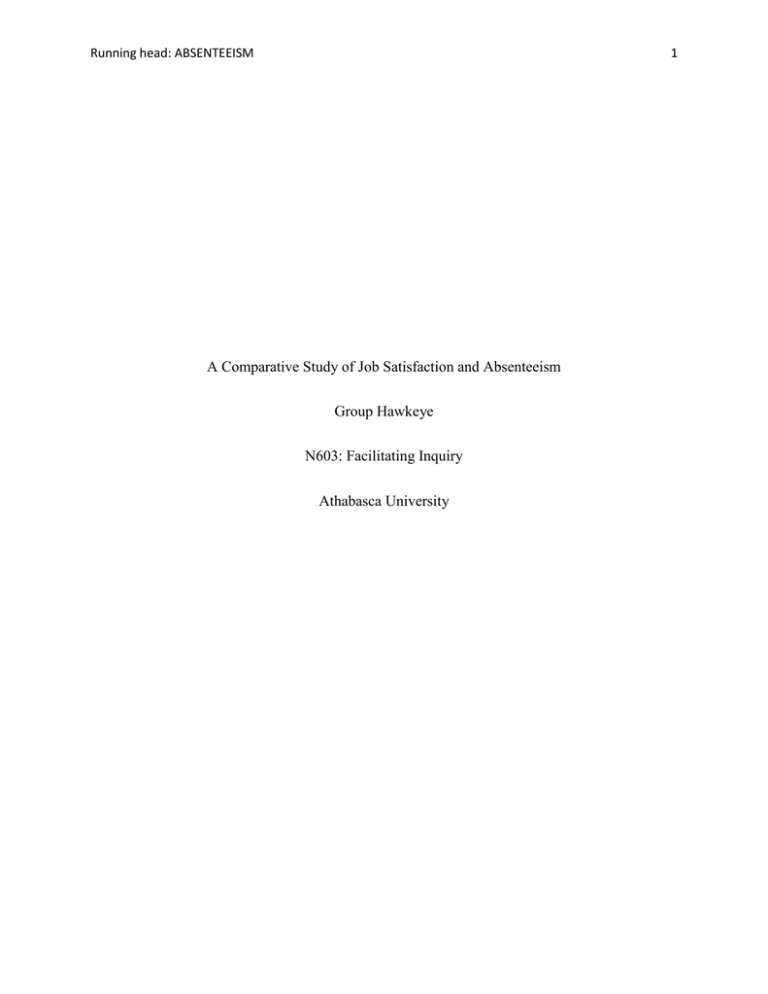
Running head: ABSENTEEISM 1 A Comparative Study of Job Satisfaction and Absenteeism Group Hawkeye N603: Facilitating Inquiry Athabasca University ABSENTEEISM 2 Abstract A comparative phenomenological study was completed to determine if absenteeism is related to job satisfaction of health care providers. Absenteeism is of increasing concern and a costly problem for health care providers and employers. Health care providers work long irregular hours, deal with stressful work situations, and cope with shrinking health care budgets which affect job satisfaction and absenteeism. The 15 female participants in this two phase mixed method study were nursing students of the Athabasca University NURS 603 research course. A randomly assigned group of five students worked together to develop five questions for a focus group to gather qualitative data regarding possible reasons for absenteeism, job satisfaction and dissatisfaction. The data from the focus group formed the basis for the 10 question survey completed online by all 15 class participants to gather quantitative data. Mean and percentage analysis showed that participants agreed that absenteeism is mainly due to personal physical illness and that absenteeism is related to job satisfaction. keywords: absenteeism, health care provider, job satisfaction ABSENTEEISM 3 A Comparative Study of Job Satisfaction and Absenteeism Within this research project we are examining if there is a relationship between job satisfaction and absenteeism. Examination of elements of absenteeism both voluntary and involuntary as well as the number of occurrences is explored. There are a multitude of predictors of absenteeism and job satisfaction. As long as the predictors remain unclear, efforts at dealing with the costly problem associated with absenteeism will be less useful (Davey, Cummings, Newbrun-Cook, & Lo, 2009). This phenomenological study involves examining nurses’ perception regarding job satisfaction, absenteeism and the relationship between the two variables, including the lived experiences as determined by the participant’s subjective reality. The following research project will strive to understand the issue of absenteeism, using both a qualitative and a quantitative research approach, starting with the research question: how does job satisfaction of health care providers relate to absenteeism? The research team formulated the following hypothesis: absenteeism is related to perceived job satisfaction; job satisfaction and absenteeism are inversely related; and decreased job satisfaction leads to possible illegitimate reasons for absenteeism. The aim of this study is to determine if absenteeism is directly related to the job satisfaction of health care providers, focusing on the nursing profession. Utilizing an online forum focus group and online survey for data collection, the results are analyzed through qualitative and quantitative methods respectively, using forum discussions and live chats to complete the analysis. Obtaining the perceptions nurses have regarding their level of job satisfaction and relating it to absenteeism yields useful information that assists in a deeper understanding, with the potential to discover findings that may be informative to health care organizations regarding their absenteeism rates and employee job satisfaction. ABSENTEEISM 4 Literature Review A plethora of research exists which links motivational variables (e.g. job satisfaction) with absenteeism, although there is little indication as to whether voluntary and/or involuntary absenteeism is being discussed (Schaufeli, Bakker & Van Rhenen, 2009). When linking absenteeism to a specific motivational variable, we must be clear about what we are measuring: absenteeism occurrences or duration of absence. Farquharson et al., (2012) report that highly demanding work with poor support, rapidly changing circumstances, shortages of resources (including staff), difficult patients and dealing with death and dying contribute not only to the stress levels, but also to the rate of absenteeism within the nursing profession. Another explanation for absenteeism include work-home conflicts that cause an increase in stress, which leads to decreased job satisfaction (Munir, Nielsen, Garde, Albertsen, & Carneirol, 2012). A further variable in the absenteeism formula is that of absence culture within a workplace. The absence culture is a group view of what constitutes legitimate grounds for being absent (Allebeck & Mastekaass, 2004). Farquharson et al. (2012) go on to state that “both work interference with home and home interference with work were associated with higher [absenteeism]” (p. 1631). Lab 1: Focus Group Method Participants. Purposeful sampling was used to obtain rich data descriptions and gain meaning of the identified experiences. Within a NURS/MHST 603 research course at Athabasca University, a randomly assigned research group consisting of five participants out of a class of 15 graduate students was created. The focus group members are all registered nurses who hold various roles in nursing: one educator, two managers, and two front line nurses. The workplace ABSENTEEISM 5 settings include university, hospital and community in the provinces of Saskatchewan, Ontario, Newfoundland and Nova Scotia. The ages of the participants range from 34 to 52 with nursing experience from 12 to 31 years. Procedure. The group participated in online discussions to construct the research question: how does job satisfaction of health care providers relate to absenteeism? This was refined into the following problem statement: The purpose of this study is to determine if absenteeism is directly related to the job satisfaction of health care providers. Through the online discussion forum and several live chats, focus group questions were developed to answer the research question. The questions were related to factors that impact job satisfaction, reasons for absenteeism and perception of the relationship between the two (Appendix A). The five questions were presented within the groups’ private forum and the participants were given a timeline within which to answer the questions and provide feedback. Data was then deidentified and compiled by the principle investigator, and analysed by the group. Ethical Considerations. In order to address ethical considerations, ethics approval was not officially sought, but approval for the study was ensured by consulting with the course instructor prior to starting the study. Before beginning the focus group the participants engaged in an online live chat where participation in the study was discussed. In this study consent was implied by participants completing the forum focus group questions. Confidentiality was ensured by coding raw data as participant one, participant two, and so on. Analysis Upon completion of the focus group, and once data was de-identified and coded, each group member was assigned a question to analyze. A constant comparison analysis was utilized. The inductive content analysis involved: open coding; creation of categories; and abstraction of ABSENTEEISM 6 themes. Open coding involved grouping data into smaller units, grouping the codes into categories; and lastly themes were abstracted from the categories created (Appendix B). The results are based on the answers provided by the five members of the focus group in the online forum, as well as two virtual chats. Results Job satisfaction. Participants described aspects of the job that provide job satisfaction. The themes that emerged included: decision making; autonomy; professional development; team work; and relationships. Participants reported that they enjoyed or valued having an opportunity for growth and development and continuous learning. Most expressed that they take pleasure in autonomy in their work and being included in the decision making process. Teamwork and relationships accounted for a significant component of job satisfaction. This included relationships with both coworkers and patients or students. A couple of participants indicated that they enjoyed flexible work hours. Role clarity, respect, fairness and kindness were also mentioned. Job dissatisfaction. Aspects of the job that lead to dissatisfaction were also shared by participants. The data elicited the following themes: shortage of staff; budget issues; lack of leadership; communication issues; and staff disengagement. Workload and long shifts were expressed as job dissatisfiers for the front line nurses. Poorly functioning teams were expressed as inequalities in workload and the system in general as well as issues with the mix of junior and senior nurses. The management group members expressed organizational challenges and budget issues as dissatisfiers. A chaotic work environment was attributed to poor leadership and a lack of organizational skills. Lack of communication and not having a voice in decisions were also expressed as negative aspects of the job. ABSENTEEISM 7 Absence from work. The results are presented in the context of the participants reasons for absence from work and the participants thoughts on why others are absent from work. The four themes emerging as reasons for absence from work include: personal physical illness; family member illness; mental health; and other. Physical illness of self or family members was the dominant reason for absence, indicated by all five focus group members. Mental health, specifically stress, was identified by all non-management participants as a reason for absence whereas the management participants noted mental health as a reason why others are absent from work. Other reasons mentioned for absence were related to bereavement, education, and appointments. Participants were asked to reflect on why they think others are absent from work. The themes elicited from this question were similar to themes related to personal absence and included: mental health; physical illness of self; and family health. It is significant to note that not all reasons under each of these themes were noted as legitimate illness. All participants identified mental health as a legitimate reason for absence. This was evidenced in the text by the words burnout, stress, and mental health day. Physical illness was also noted as legitimate and related to a range of ailments noted by the participants. Two participants commented on child care issues and the abuse of sick time. Weather conditions, travel, and personal issues such as marital discourse were also mentioned. Relationship of absenteeism and job satisfaction. There was participant consensus that a positive relationship exists between absenteeism and job satisfaction. All five participants indicated that job satisfaction does indeed impact on the frequency of absenteeism. The themes that reflected their rationales for this positive relationship include: unhappiness in their role; not feeling valued; feelings of helplessness/hopelessness/low morale; and personal factors. ABSENTEEISM 8 Discussion The group agreed that a positive relationship exists between absenteeism and job satisfaction. Interestingly, it was identified that notable differences did present themselves between the manager and non-manager nursing roles. In our study the main difference identified was that managers indicated they did not utilize a lot of sick time/rarely absent from work. Peters, Rijk, and Boumans (2009) explain that shift work has historically been the main cause of absenteeism in nursing. Most nurse managers do not work shift work hence this could explain the difference between absenteeism of management and non-management in this focus group. There were also slight differences between management and non-management responses with respect to factors that lead to job satisfaction. A limitation of this study is related to the fact that we have a small sample which does not represent the health care providers across the health care sector. Thus, we cannot use the results to make generalizations. Secondly, this is a cross sectional study, focusing on only one point in time, simply studying the relationship but not the cause and effect (Delaney, 2009). Although the primary goal of focus groups is to use interaction data resulting from face-to-face discussion, this focus group used a modified version and data was collected via private forum by posting responses online to the five questions developed, hence the benefits of observation of body language and interaction between the participants was unobservable. Lab 2: Survey Method Participants. Ideally a purposive sampling from the nursing profession would be utilized for a research project such as this. Taking into consideration the confines of an electronically delivered masters level course, the entire class has been selected as participants for the survey. ABSENTEEISM 9 This convenience sample is based on the availability of participants and was used to facilitate timely data collection. All 15 class members did participate in the survey and the sample was comprised of female registered nurses who hold various roles in nursing. The identified limitation of this sampling method is sample size and singular gender, as well as being restricted to a single online class of students. In addition, a bias identified is the need for a certain level of computer literacy in order to participate in the study. This was mitigated by the fact that the sample was drawn from those already registered in online graduate studies. Procedure. In order to further explore the research question, a survey was conducted to expand on the identified themes of the focus group. Through the online discussion forum, survey questions were developed to answer the research question using data acquired from the focus group study. The questions were related to factors that impact job satisfaction, reasons for absenteeism and perception of the relationship between the two (Appendix C). The survey was then reviewed by an expert reviewer, the course instructor, and given final approval. The 10 question survey was presented to the participants using an online survey tool, Fluid Survey. Ethical Considerations. In order to address ethical considerations, ethical standards must be just as rigorous for on line surveys as other methods of data collection. Although ethics approval was not officially sought, approval for the study was ensured by consulting with the course instructor. Two important ethical considerations are informed consent and confidentiality. Before participants were asked to actively engage in the research study, they were informed of the purpose of the study and the right to refuse to participate. In this study consent was implied by participant completion of the survey. Participant confidentiality was maintained through an anonymous online survey at the Fluid Survey website. This forum prevented the ability to identify how an individual participant responded. Typically institutional review boards review ABSENTEEISM 10 research proposals with regard to ethical implications for participants. These review boards may include other stipulations in relation to upholding participants’ rights depending on the purpose of the research and how the data is being gathered (Coughlin, Cronan, & Ryan, 2009). This study did not seek institutional research ethics board review. Analysis The analysis was guided by two general rules: directed so that the research objective could be addressed; and driven by the type of scale used for the question. Descriptive analysis was undertaken to simply describe the sample of the group from which the data was collected and to closely examine the collected data in order to describe its salient features. The survey was comprised of questions that called for different levels of measurement given the various levels of data collected. Nominal data included questions related to age, current position, and reasons for absenteeism. Ordinal data included a Likert scale to rate job satisfaction. A second Likert scale was used to seek opinion of relatedness of job satisfaction and absenteeism. Finally, ratio data related to number of times absent from work was collected. The sample was treated as a whole and analysis produced simple, un-weighted summaries. Results We can see a positively skewed distribution of age of participants, with the mode between 31 and 40. Furthermore, nearly 2/3 of the participants who answered our questionnaire are less than 40 years of age. All participants were female nurses. Participants worked in a variety of nursing positions with the majority, 56 % being front line nurses. One respondent answered both frontline nurse and nurse educator and hence was counted in both job categories. The majority of participants (53.3%) have been working in their current positions on average five years to less than 10 years. The data relating to absence over the previous year were not ABSENTEEISM 11 normally distributed, with an outlier between 8 and 10 days absent. This number affected the validity of the mean. In addition, one participant response was discounted as she was off on maternity leave. The median number of days absent was 2.5 days; with a mode of 1 day. The most commonly selected reason for absence was personal physical illness with 67% of participants identifying this as a reason for their own absence and attributed it to the absence of others at 93%. Identified reasons for job satisfaction were relatively equally distributed across the options available: autonomy (being independent in your actions); development (access to educational, professional or personal development); team work (working together as a team to meet the needs of your clients/organization); and relationships (friendships and/or partnerships). Overall staffing issues appear to be the most significant aspect of the participant’s job that leads to job dissatisfaction, with 87% of participants selecting this option when asked about contributing factors to job dissatisfaction. Workload issues, either too great or not challenging enough, was the second most frequent response and followed closely by disengaged workers. The majority of participants are satisfied with their jobs, with 60% somewhat satisfied and 26.7% very satisfied. 73.3% of participants agreed that job satisfaction of health care providers is related to absenteeism and 20% of respondents gave a neutral response (Appendix D). However what is of most interest is to compare the number of days absent to the selfdeclared level of job satisfaction. When the data is cross tabulated, it becomes apparent that there is an increase in absences as the level of satisfaction decreases. For example the mean number of absences for those who indicated they were very satisfied was two, yet the mean number of absences for those who indicate those who are somewhat dissatisfied was five. Although the majority of respondents agreed that job satisfaction and absenteeism are related (73.33%), when the data is analysed in a cross tabulated manner, we discover that the ABSENTEEISM 12 relationship is again proportional. Those that strongly agree there is a relationship between job satisfaction and absenteeism have a mean number of absences of three days, while those that disagree have a mean number of absences equal to one day. In summary, the less we agree that absenteeism is related to job satisfaction, the less we are absent. Discussion The survey findings concluded that 73.3 % of participants believe that job satisfaction is related to absenteeism. However, the sample for this study is not reflective of the average Canadian nurse. In 2010, the average age of a registered nurse in Canada was 45.4 (Canadian Institute for Health Information [CIHI], 2011). Two thirds of this study sample is less than 40. Further to this the average Canadian nurse has 18 years of experience (CIHI, 2011) as opposed to this sample average of more than five to less than 10 years’ experience. Finally, the average days lost for Canadian health care professionals range from 12 to 15 days (CIHI, 2011) as opposed to the average of this sample of nurses at 2.5 days. The bias of self-reporting may explain the discrepancy between the Canadian average and this sample population. In order to increase the validity or generalizability of this study a more representative sample would have to be accessed. Although the survey revealed a high response rate to physical illness as a reason for both self and other’s absence from work; absenteeism is influenced by a number of interrelated factors ranging from family responsibilities to satisfaction on the job (Davey et al., 2009). The 2005 CIHI report stated that nurses with absenteeism totalling more than 20 days commonly reported high job strain, low supervisor support and high physical demands on the job, low control over practice, lack of respect from supervisors or high role overload as factors responsible for absenteeism (Davey et al., 2009). There is an underlying assumption that low job satisfaction leads to high absenteeism rates and vice versa, however, research in this area is contradictory ABSENTEEISM 13 (Farquharson et al., 2012). In essence, if a correlation does exist between these two variables, managers would be able to devise focused strategies around the various aspects of job satisfaction in an effort to reduce the absenteeism levels of employees (Farquharson et al., 2012). Integration and Synthesis The results of both the focus group and the survey converge to support the conclusion that there is a perception of a strong positive relationship between job satisfaction and absenteeism. Themes that emerged from the focus group enabled the researcher to test more systematically by collecting quantitative data. The quantitative data from the survey helped to explain and elaborate on the qualitative focus group data. During analysis of the survey data it became apparent that there is an increase in absences as the level of satisfaction decreases. Although the majority of respondents agreed that job satisfaction and absenteeism are related, when the data was analysed, a proportional relationship was discovered. Those that strongly agree there is a relationship between job satisfaction and absenteeism have greater number of absences, while those that disagree have fewer absences. In short, the stronger we agree that absenteeism is related to job satisfaction, the more we are absent. Both the focus group participants and the survey respondents identified similar rational for both personal absences and the absence of others. The original research question indicated a purpose to explore the relationship between job satisfaction and absenteeism for health care professionals, although ultimately the sample accessed for both the focus group and the survey was indeed comprised completely of nurses. This limitation does present as a bias in the rational for both job satisfaction and dissatisfaction. Discussions did center on the challenges faced by nurses and the specific professional ABSENTEEISM 14 environments nurses work in and are exposed to. This anomaly in sample was discovered during the focus group sessions. Conclusion In this mixed method research project we conducted a focus group and survey to gather data. The study concludes that there is a perception of a strong positive relationship between job satisfaction and absenteeism. The data gathered from the focus group was reinforced by the data generated from the survey and therefore does give us some indication that we have reason to continue to validate the existence of a relationship between absenteeism and job satisfaction. We should also consider the impact workplace absence culture has on both voluntary and involuntary absenteeism and if this is related to job satisfaction in any way. Considering the limitations of the small sample size, lack of diversity of professional designation, as well as the discovery that the demographic of the participants do not reflect the statistics of the general Canadian nursing population, there is strong endorsement for the need for further research in order to draw any conclusions from the simple study described within this report. Research to guide the development of individual and organizational interventions to address this costly issue for individuals and organizations in order to improve the delivery of care across the healthcare system is needed. This study identified a number of workplace attributes that contribute to job satisfaction. Future research could be done to study the impact of work-life conflict and its effect on health care providers’ absenteeism and job satisfaction rates. ABSENTEEISM 15 References Allebeck, P. & Mastekaasa, A. (2004). Causes of sickness absence: Research approaches and explanatory models. Scandinavian Journal of Public Health, 32(63), 36-43. doi: 10.1080/14034950410021835 Canadian Institute for Health Information. (2011). Regulated Nurses: Canadian Trends, 2006 to 2010. Author: Ottawa. Retrieved from http://secure.cihi.ca/cihiweb/products/ RegulatedNursesCanadianTrends2006-2010_EN.pdf Coughlan, M., Cronin, P., & Ryan, F. (2009). Survey research: Process and limitations. International Journal of Therapy and Rehabilitation, 16(1), 9-15. Retrieved from http://0search.ebscohost.com.aupac.lib.athabascau.ca/login.aspx?direct=true&Auth Type=url,ip,uid&db=rzh&AN=2010179757&site=ehost-live Davey, M., Cummings, G., Newbrun-Cook, C. V., & Lo, E. A. (2009). Predictors of nurse absenteeism in hospitals: a systematic review. Journal of Nursing Management, 17(3), 312–330. Retrieved from http://0ehis.ebscohost.com.aupac.lib.athabascau.ca/ehost/pdfviewer/pdfviewer?vid=3&sid=bb6e 8c0f-68d5-4614-8ec3-b7a43870271d%40sessionmgr111&hid=115 Delaney, L. (2009). Descriptive statistics: Simply telling a story. British Journal of Cardiac Nursing, 4(6). Retrieved from http://0search.ebscohost.com.aupac.lib.athabascau.ca/login.aspx?direct=true&AuthType=url,ip,u id&db=rzh&AN=2010344153&site=ehost-live Farquharson, B., Allan, J., Johnston, D., Johnston, M., Choudhary, C., & Jones, M. (2012). Stress amongst nurses working in a healthcare telephone-advice service: Relationship ABSENTEEISM 16 with job satisfaction, intention to leave, sickness absence, and performance. Journal of Advanced Nursing, 68(7), 1624-1635. doi: 10.1111/j.1365-2648.2012.06006.x Munir, Fl., Nielsen, K., Garde, A.H., Albertsen, K., & Carneiro, L.G. (2012). Journal of Nursing Management, 20, 512-521. doi: 10.1111/j.1365-2834.2011.01308.x Peters, V., de Rijk, A., & Boumans, N. (2009). Nurses' satisfaction with shiftwork and associations with work, home and health characteristics: a survey in the Netherlands. Journal of Advanced Nursing, 65(12), 2689-2700. doi:10.1111/j.1365-2648.2009.05123.x Schaufeli, W.B., Bakker, A.B., & Van Rhenen, W. (2009). How changes in job demands and resources predict bournout, work engagement, and sickness absenteeism. Journal of Organizational Behaviour, 30, 893-917. doi: 10.1002/job.595 ABSENTEEISM 17 Appendix A Focus Group Questions 1. What are the aspects of your job that provide you with job satisfaction? 2. What are the aspects of your job that lead to dissatisfaction? 3. What are some of the reasons you are absent from work? 4. Can you identify the possible reasons why others holding a similar position to yourself are absent from work? 5. Do you think absenteeism is related to job satisfaction? If so, how? ABSENTEEISM 18 Appendix B Focus Group Data Inductively Developed Thematic Categories Category Thematic Category Aspects of Job that provide job satisfaction Decision making Key Terms Characteristic Responses Make decisions Voice in decisions I need to be included in decision making. I feel like I have a voice in decisions being made. Autonomy Autonomy Independence Responsibility I like the autonomy that I have to make decisions for my staff and my clinics. I enjoy autonomy. Development Team Work Learn new things Growth Development Learning opportunities Continuous Learning Challenge Employees are happy Included Part of bigger picture Part of something Supportive supervisor My job provides me with personal responsibility, independence, growth and developmental opportunities. I want learning opportunities for growth and to be involved in new projects. I like to learn new things everyday and in my role I learn from the team on a daily basis. I enjoy a challenge I enjoy working with a variety of health care professionals in a team environment. This makes me feel like I am part of something that is making a difference for our staff and our patients. ABSENTEEISM 19 Relationships Respect fairness kindness Working with patients Patient advocate Other Fast paced Flexible time/work hours Provide best care I like being treated with respect, fairness and kindness which my staff and more of my colleagues in my portfolio provide. The fast pace environment. I am part of something that is making a difference for our staff and our patients. Aspects of the job that lead to dissatisfaction Shortage of staff Ratio of nurses to pts., Ratio of Jr. to Senior nurses, Vacations, Staffing shortage, Due to the shortage of nursing staff, the ratio of nurses to patients, the ratio of junior nurses to senior nurses and the budgetary cuts, workload is an aspect of dissatisfaction. Staffing shortages and the fallout including: unable to take holidays, mandatory overtime, long hours and this usually leads to increased sick time and further stresses the work environment. Budget Issues Decisions dictated by money, Challenges with balancing budget adds strain to staff, Organizational challenges with balancing the budget and the strain this puts on everyone. Being dictated by money – working with pay for service personnel and witnessing the drive for money verses patient safety Lack of leadership Dislike micromanagers, Poorly functioning teams, No voice in decision making, Union runs the place, Doing things the way we When the fast passed environment is chaotic, usually in part due to lack of leadership and organizational skills from our designated leaders ABSENTEEISM 20 always have but expect different results, Communication issues Staff disengagement Reasons you are absent from work Physical illness Family member illness Mental health Doing things the way we've always done them but expecting different results. Moral & ethical challenges, Lack of communication – this is Lack of communication, an everyday occurrence in some Confusion of Board’s role in areas of the OR, communication governance & operational is used as power by some staff. issues, Lack of information, Long shifts, Picking up slack for disengaged staff causes uneven distribution of work, Increase & abuse of sick time, Mandatory OT, Not being validated, Feeling like part of a machine, Uneven distribution of work across the team members, specifically team members that are disengaged who come to work to do their tasks and do not give anything beyond the bare essentials. Legitimate sickness Flu Gastro Back pain migraine Very ill Sick Surgery Contagious illness Mother health concern Family member Son is sick Usually legitimate sickness or illness. Usually if I am very ill or contagious, I will often attend work even when ill, as the work needs to get done and no one covers my duties when I am off. Mental health day Burnt out Stressed On occasion a mental health day, usually due to the inability to take a day off perpetuated from staffing shortages. To address any of my mother’s health concerns, as I am the only one in the province to assist with her healthcare. I have taken “mental health” days when my stress level is so high that I need a break in order to keep working at the pace ABSENTEEISM 21 expected of me on a daily basis. Others Medical appointment Bereavement leave Unpaid pre approved educational day For any appointments I am unable to arrange outside work hours. Occasionally I take unpaid pre approved education leave days. Burnout Recharge batteries Hangovers Personal issues Stress leave Marriage break up Lack of organization Unable to take a day off Some employees may feel burnt out, or need a day off to recharge their batteries. Mental health day – due to inability to get time off even for scheduled life events and putting in for a particular day/time off over 6 months in advance Family Elderly family members Other family concerns Sick children Lack of child care Sick spouse Death in the family Bereavement Spouse illness Some of the “older” managers have elderly family members and they can be absent from work because of issues with those family members, e.g. doctor appointments, specialist appointments, care giving issues. Family concerns, like sick children, daycare issues Illness Sick Stress leave Illness/surgery Legitimate sickness and stress leave Surgery/diagnosed with illness example: cancer Other Severe weather Interviews Travel Abuse Just because they didn’t feel like working today – abuse of sick leave. Severe weather conditions, hang-over, lack of organization for events or appointments on work days; in addition to few of them abusing the system. Possible reasons others are absent from work Mental health ABSENTEEISM Relationship of absenteeism and job satisfaction Unhappy in their role Not feeling valued Feelings of helplessness/hope lessness/ low moral Personal Factors 22 Dissatisfaction with current responsibilities Staff shortages/excessive overtime Lack of responsibility Staffing shortages have led to excessive overtime that affects home life as well, thus staff are unhappy being forced to work and take a day off to recuperate from the over time. Do not feel valued by the organization. Do not feel rewarded/treated fairly. Lack of acknowledgement or appreciation. Lack of communication. Higher levels of turnover. Reduced productivity. Grievances, tardiness. Persons who do not feel rewarded and/or that they are treated unfairly are more likely to be absent from work. Do not believe the situation will change. Stress at home. Personal characteristics. Sense of entitlement. Poor work ethic. I think a greater determinant of absenteeism than job satisfaction is personal factors such as attitudes toward work, personal characteristics and situational factors. I do believe that absenteeism is related to job satisfaction. If a manager is not happy with their role, do not feel valued by the organization and do not believe that the situation is going to change or that they have any ability to change it then I have witnessed that they are absent from work. ABSENTEEISM 23 Appendix C Online Survey Data Analysis 1) 2) 3) 4) What is your age group? a) 20-30 b) 31-40 c) 41-50 d) 51 or more What is your current position (check all that apply)? a) Nurse manager b) Nurse educator c) Nurse practitioner d) Frontline nurse e) Corporate nurse f) Research nurse g) Other, please specify: How long have you been working in your current position? a) less than 1 year b) 1 year to less than 3 years c) 3 years to less than 5 years d) 5 years to less than 10 years e) 10 years or more How many times were you absent from work during the last year? Please indicate number of shifts. a) ___________(fill in the blank) b) ___________Don’t know ABSENTEEISM 5) 6) 7) 24 What are some of the reasons that you were absent from work? (choose all that apply) a) Personal physical illness b) Family member illness c) Mental health d) Family responsibility (for example, childcare needs or attending to elderly parents) e) Needed/wanted a day off f) I am entitled to take my sick days g) Other, please specify............ What are some of the reasons that others are absent work? (choose all that apply) a) Personal physical illness b) Family member illness c) Mental health d) Family responsibility e) Needed/wanted a day off f) I am entitled to take my sick days g) Other, please specify............ What aspects of your job provide you with satisfaction? (choose all that apply) a) Included in the decision making process – awareness of proposed changes, having a say b) Autonomy – being independent in your actions c) Development – access to educational, professional or personal development d) Team work – Working together as a team to meet the needs of your clients/organization 8) e) Relationships – Friendships and/or partnerships f) Other, please specify...................... What are aspects of your job that lead to dissatisfaction? (choose all that apply) a) Staffing issues b) Budget issues c) Lack of leadership ABSENTEEISM 9) 10) 25 d) Lack of communication e) Workload too great, or not challenging enough f) Disengaged coworkers (e.g. not involved, lack enthusiasm about work) g) Other, please specify.................. Rate your job satisfaction: a) Very satisfied b) Somewhat satisfied c) Neither satisfied nor dissatisfied d) Somewhat dissatisfied e) Very dissatisfied Do you think being absent from work is related to job satisfaction? a) Strongly agree b) Agree c) Neutral d) Disagree e) Strongly disagree ABSENTEEISM 26 Appendix D Data Analysis (Survey) Q5: Reasons you were absent from work Comparative Table: Questions 5 and 6: personal physical illness family member illness mental health 0 1 0 1 0 1 family 0 responsibility 1 needed/wanted 0 a day off 1 I am entitled 0 to take my sick 1 days other 0 1 Q6: Reasons you think that others were absent from work personal family menta family needed/ I am physical member l respons wanted entitle illness illness health ibility a day off d to take my sick days 0 1 0 1 0 1 0 1 0 1 0 1 1 4 0 10 2 10 1 2 6 7 0 2 3 7 0 5 5 8 0 2 8 6 0 1 other 0 1 9 3 0 3 Comparative Table: Questions 9 and 10 Do you think being absent from work is related to job satisfaction Rate your job satisfaction Very satisfied Somewhat satisfied Neither satisfied nor dissatisfied Somewhat dissatisfied Very dissatisfied Strongly agree 2 1 Neutral 0 Disagree 1 Strongly disagree 0 2 5 2 0 0 0 0 1 0 0 1 0 0 0 0 0 0 0 0 0 Agree

